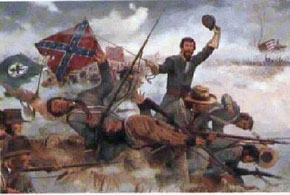Civil War Battles |
Colonial Wars |
American Wars |
Link To This Page — Contact Us —
The Battle of Spring Hill
November 29, 1864 in Maury County, Tennessee
Franklin & Nashville Campaign
Union Forces Commanded by:
Maj. Gen. John M. Schofield
Confederate Forces Commanded by: Gen. John Bell Hood
**Missing and Captured Conclusion: Union Victory |
 |
BATTLE SUMMARY
Maj. Gen. George H. Thomas, headquartered at Nashville, had ordered Schofield to intercept the Confederate army and slow their advance, to gain him time to organize his forces and prepare his defenses at Nashville.
With Gen. Hood's arrival on November 26, he devised a plan to outflank Schofield's forces, which had positioned themselves just north of the Duck River, and across the Columbia to Franklin Pike. His army would need possession of this pike if they were to march northward to Nashville. The plan called for 3/4 of his army to march around Schofield's army, while leaving Lee's Corps and the bulk of his artillery to demonstrate in front of Schofield, and mask his movements. Hood's destination was Spring Hill, Tennessee, which was 12 miles north of Columbia and 12 miles south of Franklin.
Spring Hill was the prelude to the Battle of Franklin. On the night of November 28, Gen. John B. Hood's Army of Tennessee marched toward Spring Hill to get astride Maj. Gen. John M. Schofield's Union army's life line. Cavalry skirmishing between Brig. Gen. James H. Wilson's Union cavalry and Maj. Gen. Nathan B. Forrest's Confederate troopers continued throughout the day as the Confederates advanced.
On the 29th, Hood's infantry crossed Duck River and converged on Spring Hill. As the Confederate infantry was moving up into position, Union reinforcements were arriving from Columbia to secure the perimeter of Spring Hill. By the time Cheatham's 3 divisions were in place, darkness had fallen and the Confederate attack was stalled. What followed, on the evening of the 29th, was a total breakdown of miscommunications among the Confederate command and disjointed efforts to gain control of the vital Franklin Pike. In the meantime, Maj. Gen. Schofield reinforced the troops holding the crossroads at Spring Hill. In late afternoon, the Federals repulsed a piecemeal Confederate infantry attack. During the night, the rest of Schofield's command passed from Columbia through Spring Hill to Franklin.
Schofield managed to extricate his entire army from a perilous situation, marching silently by the Confederate army during the night, and on towards Franklin. On the morning of November 30, Hood was again in pursuit of Thomas's forces, but had missed a golden opportunity to destroy Schofield's forces, which would result in the bloody battle of Franklin on November 30.
At Spring Hill, the Federals suffered 350-killed, wounded and missing, the bulk of them in Bradley's Brigade, Wagner's division. The Confederates lost 500-killed, wounded and missing, the bulk of those within Forrest's and Cleburne's commands. This was, perhaps, Hood's best chance to isolate and defeat the Union army. The engagement has been described as "one of the most controversial non-fighting events of the entire war."
